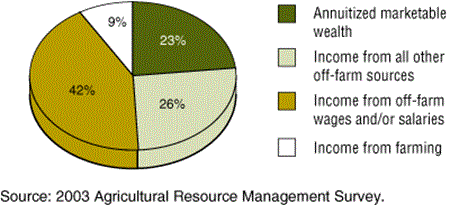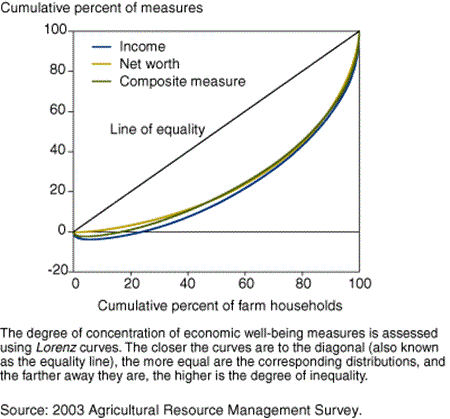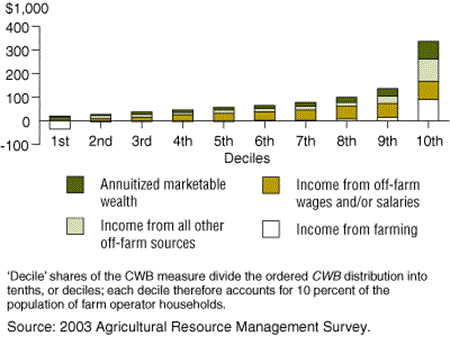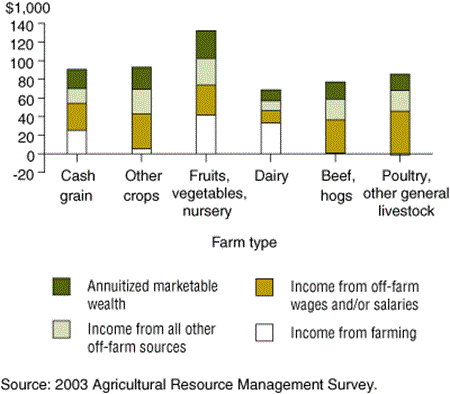Composite Measure of Economic Well-Being
Composite Measure of Economic Well-Being
The economic well-being of farm households is a recurring theme in farm policy, but accurate and objective assessment of economic well-being is difficult because income and wealth measures alone provide an incomplete picture of the economic position of the farming unit. Vagaries of weather and the biological risks inherent in agricultural production, for example, contribute to variability in the income of farm households. Similarly, some farm business wealth (e.g., land, machinery, and other capital assets) is not easily converted into forms to support household consumption in times of low incomes.
ERS has recently developed a composite measure of economic well-being (CWB) that incorporates household income and an annuity based on the amount of marketable wealth held by the household. While the use of CWB is not new to economists or ERS, the richness of data collected through the USDA's Agricultural Resource Management Survey (ARMS) in recent years allows for a more comprehensive and robust measure of economic well-being.
The CWB indicator includes all household income and the annualized value of the household's marketable wealth, those household assets that can be easily converted into cash to support household consumption needs. Annuitized marketable wealth excludes the primary income-producing assets of the farm business, like land and machinery.
The composite measure of economic well-being is estimated at $86,386 for the average farm household in 2003. Income from farming comprised $7,383 (9 percent) of the total. In contrast, income from off-farm wages and salaries accounted for $36,433 (42 percent) of the combined totals. Income from all other off-farm sources was $22,384 (26 percent), and marketable wealth at $20,187 (23 percent). These patterns indicate the importance to farm households of policies unrelated to agriculture, such as those that encourage sustained growth in the general economy and higher rates of savings.
Adding annuitized wealth to income lessens the degree of inequality among households
The distributions of income, the composite measure of economic well-being, and of the total net worth (i.e., from farm and nonfarm sources), based on the concept of the Lorenz curve, appear to be generally similar for all farm households except for those at the lower ends of the distributions. The distribution of household income is consistently less equal than the distribution of net worth, and the distribution of CWB lies between the two. The evidence of greater equality in the distribution of CWB compared with income results from farm households with negative or low income tending to have, on average, positive net worth.
Half of all farm businesses did not make a profit from farming in 2003
Farm households in the lower half of the CWB distribution earned negative incomes from farming. Those in the first decile of the CWB distribution report that the combination of income from off-farm sources along with annuitized marketable wealth was not large enough to offset losses from farming in 2003.
Sources of economic well-being vary by farm specialization
In 2003, economic well-being of farm households was highest for farm households specializing in the production of fruits, vegetables, and nursery products. These farm household types also averaged more income from farming than all other farm types. In contrast, the economic well-being of households with livestock as their specialty (with the exception of dairy producers) was mainly comprised of off-farm income and of annuitized farm and nonfarm wealth.
Farm households' economic well-being reaches its peak as farmers get closer to retirement
The potential income stream from marketable wealth accumulation was an important component of the economic well-being of all farm households in 2003, especially for older farmers. In contrast, income from off-farm wages and salaries comprised the largest portion of the composite measure of well-being for farmers under 65.
Farm Sector Income & Finances, by Farm Income Team, USDA, Economic Research Service, February 2024






